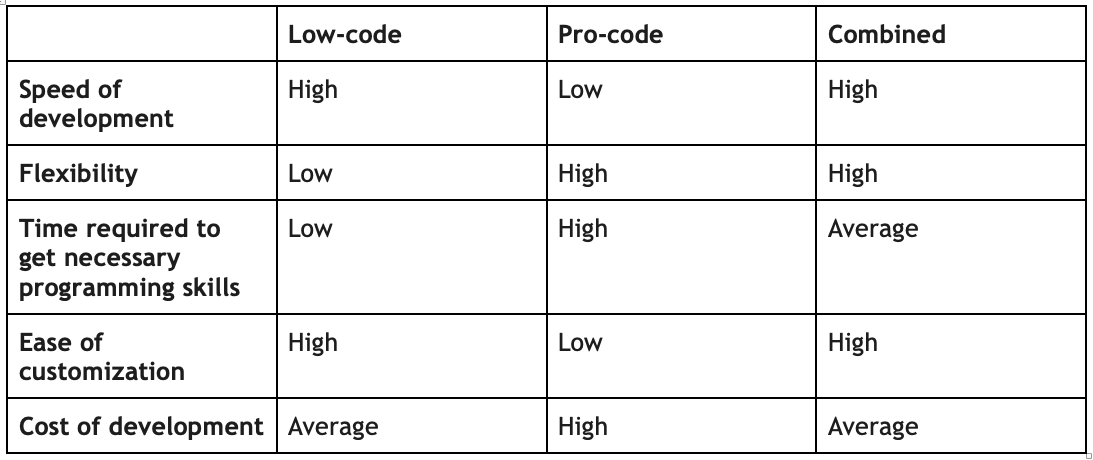
When it comes to software and app design, businesses are no longer restricted to labour-intensive conventional coding platforms. Other simpler alternatives have been emerging into the spotlight: no code, low-code, and pro code. So how do the business leaders decide on the best solution to their projects?
No code, Low-code and Pro-code
No-code development is a type of declarative programming in which applications are built using drag-and-drop user interfaces. This approach aims to boost speed and efficiency where extensive and intricate coding is unnecessary. Simple, repetitive applications based on common use patterns can be effectively created with typical no-code platforms. When technical skills like software engineering and web development are hard to learn, time-consuming, and not always desirable, reaching the desired destination as simply as possible is the primary reason for the rise of no-code development:
Low-code platforms, like no-code platforms, also use a graphical interface for building an application but opens up possibilities for "light" coding additions. Since low-code requires minimal manual coding, developers can focus on creating the 10% that makes their application different while leaving the standard pieces to the drag-and-drop features. Low-code may be the best method for quick implementation and development, saving time and money while also providing the power to tailor to business requirements.
We have professional or "Pro-code"software development at the other end of the spectrum. The conventional and professional software buildup is very different in nature and complexity than no/low-code. It is essentially created from scratch by only experts who are trained in using specialized programming languages like Python and SQL. Pro-code costs more and is typically more time-consuming than the lower-code approaches, but businesses benefit from its higher customization abilities, security, and scalability.
Which one is the best fit?
By 2024, Gartner estimates that low-/no-code tools will lay the foundation for 65% of all app development[1], while Forrester estimates that low-code and no-code resources will be worth up to $21 billion in 2022 [2]. Demands for fast development are at an all-time high, and the hustle requires a lightweight approach. And while no-code and low-code are more manageable and less expensive, they are not necessarily the best option for every application.
Low-code is ideal for creating independent mobile and web apps and portals that will need to integrate with other systems and data sources. In fact, except for highly sophisticated, mission-critical systems that interface with various backends and external data sources, low-code can be used for almost anything. On the other hand, no-code tools should only be utilized for front-end work.
Pro-code outperforms no-/low-code when it comes to robust systems that can handle complex workflows. While no-/low-code apps could manage minor parts of such a structure, they lack the sophistication to endure the entire system. Pro-code enables specialists to perform accurate calculations, categorize and track large quantities of products, and handle real-time routing and processing orders for multiple clients.
Some examples of the projects and their appropriate software development method:
- Low-code: Legacy system modernization, CX applications
- No-code: Building product prototypes (app prototypes, e-commerce solutions, blogs); landing pages; single-page sites; customer-facing or apps with simple functionality.
- Pro-code: Projects that require a robust system or offer fresh unicity in the market; Large-scale products with abundant complex features.
Fusing the approaches
Here is how businesses can benefit from low-code, pro-code, and the combined approach:

Sticking to one approach - like low-code only, for instance - is not always necessary and slows down development. A better solution would be to use both. Combining low-capabilities codes with full-stack and citizen developers' expertise allows seamless collaboration between pro-code and low-code. This fusion enables IT architects and full-stack developers to consume data from any database or business system, and increase data streams by generating platform-independent business and IT logic. While low-code is utilized in creating visual models, pro-code can be used to cater to a wide range of user requirements. The connection of the two platforms creates a dynamic structure of front-end and backend tools that allow developers to make apps quickly and efficiently while offering customization and long-term viability.































